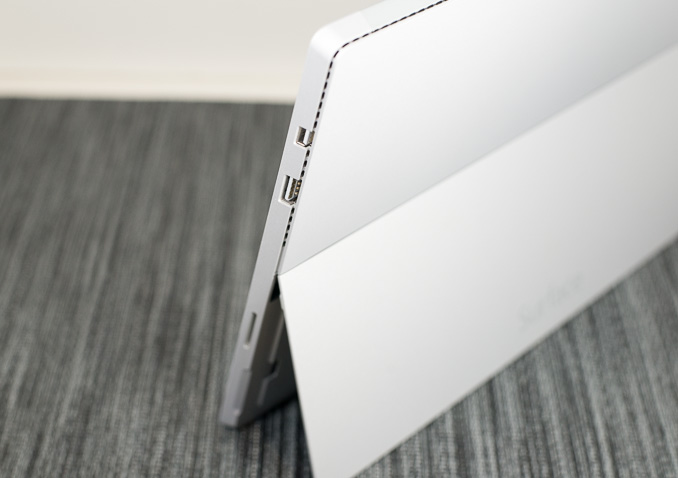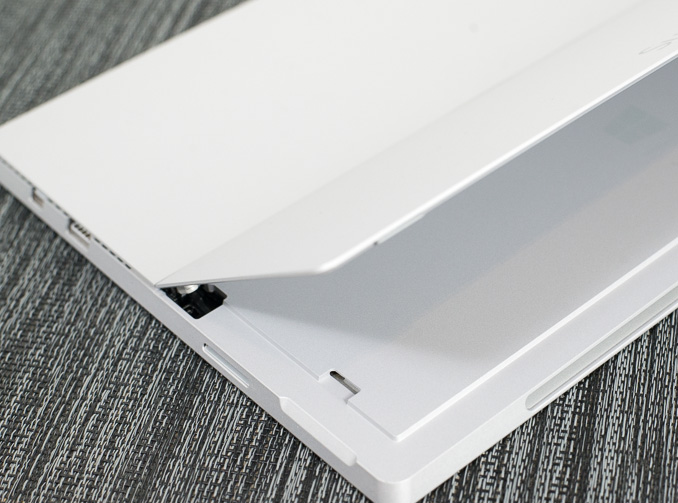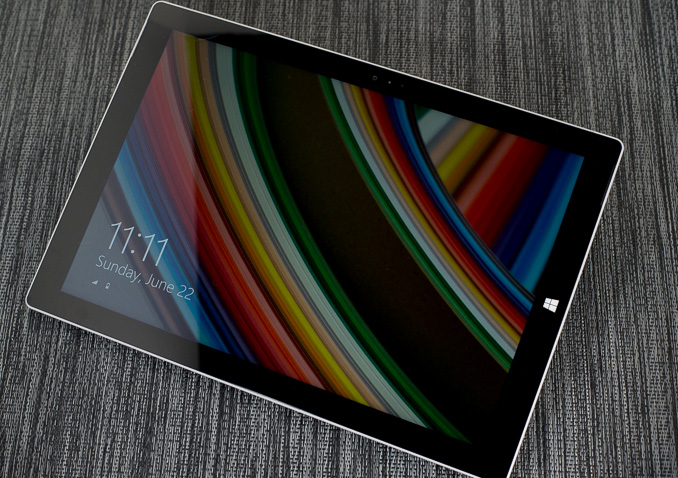Microsoft Surface Pro 3 Review
by Anand Lal Shimpi on June 23, 2014 3:55 AM ESTFinal Words
When I reviewed the first Surface Pro I was intrigued by the idea, but felt it needed a few more iterations to get to the right point. In less than two years what we have in front of us looks very different than Microsoft's original vision for the platform. Display size, aspect ratio and even the mechanics of the whole thing are all quite different. The changes are for the better as Surface Pro 3 is a much better laptop and a much better tablet than any of its predecessors. The device no longer feels cramped and tiring to use as a laptop. The new Surface Pro no longer feels heavy to use as a tablet either. It's truly an improvement on both vectors.
Microsoft might be overselling the design to say that it truly is the only device you need. Like most compromises, Surface Pro 3 isn't the world's best laptop nor is it the world's best tablet. It serves a user who wants a little of column A and a little of column B.
The device's "lapability" is tremendously better than any of its predecessors. While I wrote all of the previous Surface reviews on the very Surface devices I was reviewing, this is by far the most comfortable one to use as a laptop. It's still not perfect, and you still need a fairly long lap to make it work, but the design is finally really usable as a laptop.
As a tablet the thinner and lighter chassis is much appreciated. The new kickstand remains one of the best parts of the design, enabling a flexibility unmatched by any other tablet. Tent mode in particular is awesome for tablet usage models.
Surprisingly enough the move away from Wacom to an active NTrig pen model comes with very few issues. The device could use some tuning of its pen pressure curves. Applying max pressure on the screen now distorts the LCD, something I'm never comfortable doing. But overall the new pen gives up very little and even improves performance and functionality.
The new Type Cover is awesome. The keyboard is probably as good as it's going to get, and the new trackpad is finally usable. The latter isn't perfect but it's so much better than anything that's come before it.
The device also launches with a far more polished version of Windows. With its latest updates, Windows 8.1 is a far cry from where it first started. I still think there's lots of room for improvement, but it's clear that Microsoft is marching towards a more cohesive vision of modern and desktop Windows UIs.
The downsides for Surface Pro 3 are obvious. Windows 8.1 remains a better desktop/notebook OS than a tablet OS. Yet in a device like Surface Pro 3 where you're forced to rely on touch more thanks to a cramped trackpad, I'm often in a situation where I'm interacting with the Windows desktop using the touchscreen - a situation that rarely ends well. As Microsoft improves the behavior of its modern UI apps, I would love to see a rethinking of what touch looks like on the desktop. If Surface Pro 3 exists to blur the lines between laptop and tablet, Windows 9 needs to do a better job of the same. The desktop needs to react better to touch and the modern apps need to feel even more integrated into the desktop.
On the hardware side, the device is a compromise. You have to be willing to give up some "lapability" in order to get a unified laptop/tablet device. Whether what you get as a tablet is worth the tradeoff is going to be up to how good of a tablet OS Windows 8.1 is for you. Personally I find that Android and iOS deliver better tablet experiences particularly when it comes to 3rd party applications. If everything you need on the tablet front is available in the Windows Store however then the point is moot.
Those users upgrading from Surface Pro 2 may notice a regression in performance, particularly when it comes to running prolonged CPU/GPU intensive workloads. In games, the difference can be noticeable. The simple fact is that in becoming a thinner device, Surface Pro 3 inherited more thermal constraints than its predecessors. While performance regressions aren't ideal, in this case I can appreciate what Microsoft has done. From the very beginning I wanted a lower TDP part in a thinner chassis. Had Microsoft done that from the start we wouldn't have seen any performance regression but rather a steady increase over time. From my perspective, Surface Pro 3 is simply arriving at the right balance of thermals and performance - the previous designs aimed too high on the performance curve and required an unreasonably large chassis as a result.
The remaining nitpicks are the same as last time: Microsoft needs to embrace Thunderbolt, and a Type Cover should come with the device. The display's color accuracy is good but grayscale performance needs some work.
Surface Pro 3 is easily the best design Microsoft has put forward. If you were intrigued by the previous designs, this is the first one that should really tempt you over. I was a fan of the original Surface Pro, and with Surface Pro 3 I think Microsoft has taken the hardware much closer to perfection. At this point the design needs more help on the software side than hardware, which is saying a lot for the Surface Pro hardware team. Personally I'd still rather carry a good notebook and a lightweight tablet, but if you are looking for a single device this is literally the only thing on the market that's worth considering. I don't know how big the professional productivity tablet market is, but it's a space that Microsoft seems to have almost exclusive reign over with its Surface line. With its latest iteration, Microsoft is serving that market better than ever.













274 Comments
View All Comments
ymcpa - Monday, June 23, 2014 - link
A decent laptop is $500-$600. A decent 10" tablet is around $400. Those two devices will cost about the same as the surface. Each of those devices will perform a little better than the surface is certain tasks, but you have to carry both of those devices with you to get the same functionality as the surface. The MacBook air (don't know why you mentioned the MacBook pro which is much more expensive) has the better keyboard but can't really do any tasks that the surface can't. Same with the Ipad Air. It is lighter and has a longer battery life, but can't perform any task that the surface can't. However, you will need both those devices to perform the same task as a single surface.basroil - Tuesday, June 24, 2014 - link
Where the hell can you find a decent laptop for $600? The cheapest ones on newegg are about $800!ymcpa - Tuesday, June 24, 2014 - link
depends what your definition of decent is. The newegg list of most popular laptops has plenty of laptops in the $500's and $600's. They will probably meet the needs of many people. I used that price range because a person arguing that the surface is too expensive would most likely buy a budget laptop.basroil - Thursday, June 26, 2014 - link
"I used that price range because a person arguing that the surface is too expensive would most likely buy a budget laptop. "That has to be a joke? Microsoft is selling a premium product and makes no effort to hide it. "People say it's too expensive and instead buy a budget laptop" is not a valid response, since a decent laptop WITH THE SAME SPECIFICATIONS (other than screen of course) generally runs you just as much. Pentium, Celeron, and AMD chips are NOT decent laptop components, they are budget garbage for people who don't understand the difference.
joaoasousa - Tuesday, June 24, 2014 - link
The Surface is competing in the top end with it's high build quality and thinness, you can't compare it to plastic 600$ laptops. You must put it against similar products like the Macbook Air, Zenbook, etc.mkozakewich - Monday, June 30, 2014 - link
The Air has a better trackpad, but I wouldn't say it has a better keyboard. Different people like different things, and the Surface family has my favourite keyboard ever. I was using an HP Mini netbook in 2010 which was my previous favourite, and had a similar keyboard.Honestly, those big mechanical things just required too much horizontal and vertical travel and were annoying to use.
You're welcome to like the keyboards you like, and maybe get one of those Cherry MX mechanical keyboards, or stick with the one on the Air, but that doesn't mean something is 'better', only that it's more suited to you.
(Think of what one of those mechanical-switch people would say about the keyboard on the Macbook Air.)
PaulC543 - Tuesday, June 24, 2014 - link
Did *you* read the article, or did you just see a headline that mentioned the Surface and felt you had to criticize it?What bases does it cover? Let's see:
Media consumption tablet, check.
Light productivity work while mobile, check.
Heavy productivity work while docked, check.
Light to medium gaming, if that's your thing, check.
Single device that can handle tablet and laptop tasks, check.
In fact, this would probably be easier if you name a base the Surface *doesn't* cover, and make sure whatever you mention are tasks appropriate for notebooks/tablets. As far as I can tell, the only things you can bring up are:
Heavy mobile text entry (but put it in a dock with a desktop keyboard and mouse and it's as good as any desktop/notebook)
High-end gaming.
Latest and "greatest" "apps".
That's really about it.
As for a lower cost option, you *are* aware that Dell, Lenovo, Acer and the like are building $200-$300 Intel Atom based full Windows 8 tablets, aren't you? There's your Windows tablet entry device. Niche product? Literally everyone who's seen my Surface Pro 2 has said it's the device they want as their "mass market" iPad has proven so useless that it just sits on a shelf.
TEAMSWITCHER - Tuesday, June 24, 2014 - link
I would dispute your "Heavy Productivity While Docked" claim. Merely docking the Surface doesn't automatically give it a quad core processor with discrete graphics. So what does that leave? A single device that could serve as a Tablet or Notebook suitable for media consumption, light productivity, and lite gaming...all for the not so low price of $1177+tax (with keyboard and Pen)If your needs are humble I can see the Surface Pro 3 working well, but there are devices costing hundreds less that could do the same. I know many people who's PC's are now e-waste - an iPad and iPhone are their only devices. But for an enthusiast or power user the Surface Pro 3 will always be a secondary device to a more capable computer.
PaulC543 - Tuesday, June 24, 2014 - link
"I would dispute your...."Is your dispute based on hands-on experience? Because mine is. I attach mine to my 30 inch monitor and desktop keyboard/mouse, and it easily handles 3D modeling and Photoshop work. Certainly not to the level of my workstations, but when they're tied up rendering, the Surface easily fills in.
And this is why I said to make sure the tasks you mention are appropriate - of course it's not going to offer workstation-level performance, but no ultrabook class laptop will either.
As for the price, this has been beaten to death. The Surface is entirely in-line with ultrabook-class laptops, offers key features they typically don't (touch screen, pen input, etc.) and is able to serve as a straight tablet. Add the price of a laptop AND a tablet, and you're going to spend more and have to carry at least several times the weight/bulk of the Surface.
Everything you're written speaks quite loudly to the fact that you don't see the value in what the Surface offers and have never used one. Why, then, are you compelled to criticize a device which you clearly don't understand or would ever purchase?
TEAMSWITCHER - Tuesday, June 24, 2014 - link
I never said I didn't see value in it. I think it's a great device along the lines of other great machines like Apple's entire MacBook line and Lenovo's ThinkPad Carbon X1 Touch and Yoga 2.But your claims are just ridiculous... An iPad Air weighs only 1 pound..the iPad mini weighs much less. Adding a tablet to a notebook doesn't add "Several times the weight/bulk" it's not even 1-time the weight and bulk. Finally a two-in-one device isn't the same as having two devices. I can prop my iPad up next to my MacBook for a second screen. You can't do that trick with a Surface Pro 3, unless you carries another tablet with you.